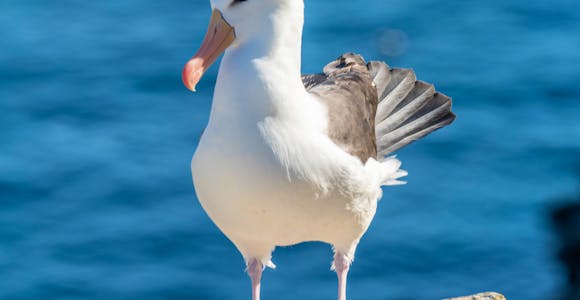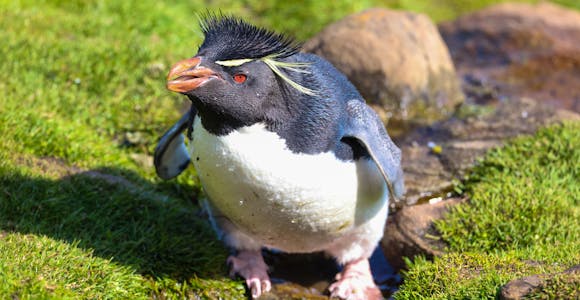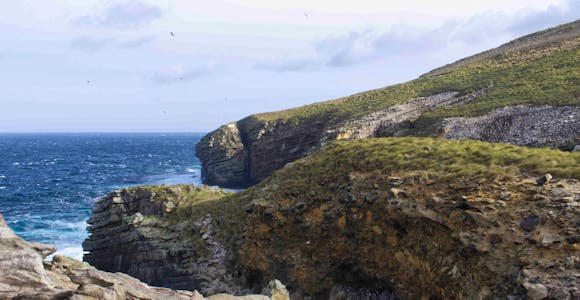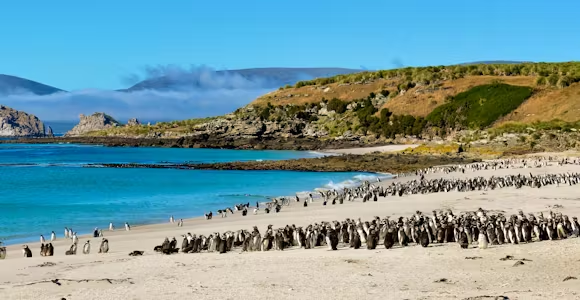
West Point Island
West Point Island is home to a large cliffside colony of black-browed albatross at the end of a hillside hike, which makes it a popular call for expedition cruise ships.
Discover More
Stanley, capital of the Falkland Islands
Stanley is the capital of the Falkland Islands. Formerly known as Port Stanley, it was founded in 1843 on account of its superb deep-water harbour. The timing was particularly fortuitous, when the California Gold Rush hit in 1849, Stanley thrived as a safe haven for repairs to ships damaged in the treacherous waters around Cape Horn. Its boom years started to end in the 1890s when stronger steamships came into service, then were snuffed out completely with the opening of the Panama Canal.
Stanley remained an important coaling station for the Royal Navy, and after the outbreak of the First World War cruisers based here won a bloody battle against the German Fleet near here in the Battle of the Falklands in December 1914.
For much of the 20th century Stanley served as the quiet capital for Falklands wool exports, until it was occupied by the Argentinian army in April 1982. After heavy fighting at Wireless Ridge and Mount Tumbledown near Stanley, its garrison surrendered to British forces on 14 June 1982. A substantial British military presence has remained ever since.
The capital's economic mainstay is now geared to tourism and management of the islands' substantial fisheries. Don't be surprised if you here Spanish being spoken here; the town attracts many migrant Chilean workers.

The blue whale jawbone arch outside Stanley's Christchurch Cathedral
Stanley is a small town that can easily be explored by foot. Many of the main attractions can be found along Ross Road, which runs along the waterfront in both directions from the jetty where you land.
The town's most prominent landmark is Christchurch Cathedral, dating from 1903 and the southernmost cathedral in the world. It is instantly recognisable from the whalebone arch standing outside. It is made of the massive jawbones of four blue whales and was a gift to the island from the South Georgia whalers in 1933.
Past the cathedral you'll quickly reach the museum. Continue on from here for the memorial to the 1982 War, and beyond that Government House and the 1914 Battle Memorial. You'll soon reach the limits of this tiny town.
You don't really need a map to get around Stanley, but the tourist office has a useful free pamphlet of self-guided walks around the town if you want to explore more.

The Historic Dockyard Museum in Stanley
The excellent Historic Dockyard Museum should not be missed when in Stanley.
The museum is on two levels. Downstairs has a wide variety of exhibits telling the story of the islands, with a large emphasis on the social history of its inhabitants. Unsurprisingly, there is sizeable section on the 1982 War with some moving testimonies from those caught up in the conflict. Those for whom the Falkland Islands is only he first stop on their itinerary will no doubt get excited by the room about the islands' links to Antarctic exploration and science, including a reconstructed hut.
The upstairs is dedicated to Falklands wildlife, with a touching exhibit on the warrah or Falkland Islands wolf. This large fox was the island's only native land mammal and was observed by Charles Darwin during his visit in 1834. Within 50 years, hunters had driven it extinct. A selection of ship models of famous local wrecks rounds out the exhibition.
The museum is open whenever there is a cruise ship in harbour and entrance is free upon showing your ship ID.

The wreck of the Lady Elizabeth near Gypsy Cove
Many expedition cruise ships include an excursion by bus to Gypsy Cove, on the northeast peninsula northeast of Stanley. The cove is home to a colony of magellanic penguins. The birds make their burrows in the peaty soil above the white sand beach: it's important to stick to the well-trodden paths here to avoid the risk of crushing burrows hidden among the heather. Access to specific breeding areas is restricted, and the Falklands countryside code advise you to maintain at least 6m between you and any penguins.
A boardwalk up from the cove leads to Ordnance Point, where there is a ship's gun left over from the Second World War.
On the way to Gypsy Cove, most excursions also stop at Whalebone Cove to see the picturesque wreck of the Lady Elizabeth, which has been lying here since 1936.

Magellanic penguin at Gypsy Cove
As a town, Stanley is not a wildlife destination, although visitors may sometimes be greeted by South American sealions snoozing on the jetty when they arrive by zodiac. Upland geese are also commonly seen on grassy areas near the shoreline.
Birdwatchers will be keen to visit Gypsy Cove outside Stanley. As well as its famous colony of magellanic penguins, there is also a reasonable chance of seeing Falkland steamer ducks on the beach. The cliffs above the cove are also home to nesting black-crowned night herons and rock shags. Peale's and Commerson's dolphins are common visitors to the cove.
At Whalebone Cove, look for waders on the mudflat, including magellanic oystercatchers, two-banded plovers and white-rumped sandpipers that heroically migrate here ever year from the Arctic.
Price Match Promise - We’ll match any price you find elsewhere for the same trip
Expedition cruise ships anchor in Stanley harbour and transfer guests to the main jetty by zodiac. The tourist office is immediately opposite the jetty and has a gift shop and a series of informative pamphlets. You can also send postcards from here. All prices are in £GBP.
The main attractions, are an easy walk from the tourist office, including the museum and local pubs and restaurants.
Some travellers may be interested in organising specific shore excursions for when they arrive in Stanley such as to birding spots or sites associated with the 1982 war. These will be confirmed when on the ship rather than when booking your voyage. Fees are paid locally; talk to the passenger manager on board the day before you are due to arrive in Stanley to confirm arrangements.
There are no biosecurity controls due to the Falklands' long history of human habitation.

West Point Island is home to a large cliffside colony of black-browed albatross at the end of a hillside hike, which makes it a popular call for expedition cruise ships.
Discover More
Saunders Island offers the chance to see four penguin species in one Falklands location, as well as a black-browed albatross colony
Discover More
In the southwest of the Falklands, New Island is one of the most scenic places in the archipelago, and is home to one of its most busiest and thriving seabird colonies.
Discover More
The white sandy beaches of Carcass Island are a popular draw for expedition cruise ships, with visitors coming here for the colonies of magellanic and gentoo penguins.
Discover MoreWe'll spend some time listening to your aspirations, then discuss the kind of experience that might suit you.
Next we'll discuss the options, shortlist the best trips for you and present you our impartial recommendations.
We'll place a 24 hour hold on your preferred option - without obligation - whilst we talk through the details.